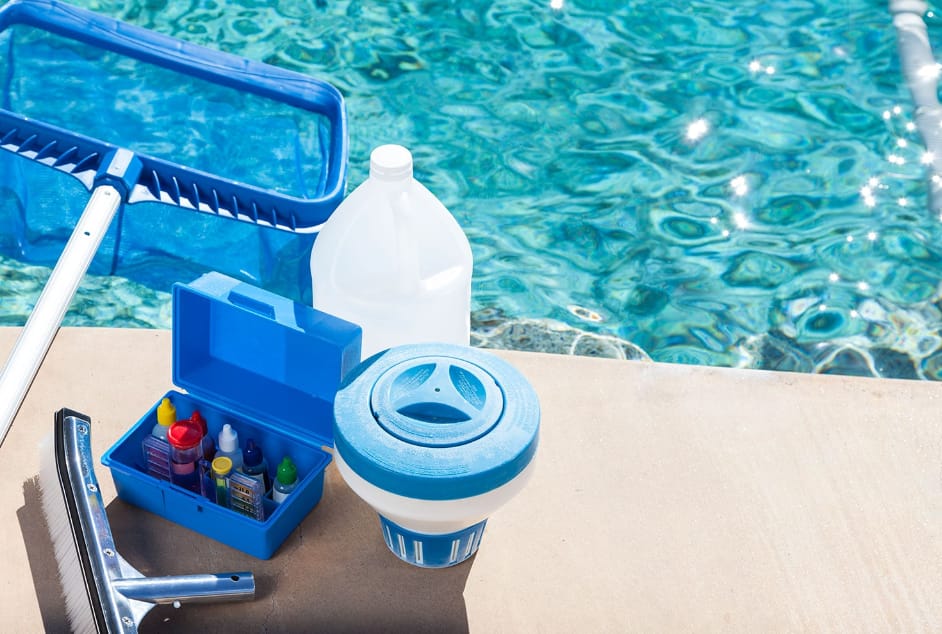Essential Tips for Maintaining a Clean and Safe Pool: A Guide to Pool Water Chemistry
Maintaining a sparkling clean and safe pool isn’t just about skimming leaves or vacuuming debris—it’s also about ensuring your pool’s water chemistry is perfectly balanced.
From pH levels to the right mix of pool chemicals, understanding how to manage these factors is key to a healthy swimming environment. In this guide, we’ll walk you through the basics of pool water chemistry, the essential chemicals involved, and tips for keeping your pool in top condition.
Understanding the Basics of Pool Water Chemistry
The foundation of good pool maintenance starts with understanding the basics of pool water chemistry. One of the most critical aspects is maintaining the right pH balance. T
he pH level of your pool water measures how acidic or basic the water is, with a scale ranging from 0 to 14. Ideally, you want to keep the pH level between 7.2 and 7.6. This range is not only comfortable for swimmers but also helps protect your pool equipment from corrosion or scaling.
Important Factors
Alongside pH, total alkalinity is another essential factor to monitor. Alkalinity acts as a buffer for pH levels, helping to prevent drastic changes that can cause irritation to swimmers’ eyes and skin.
The recommended level for total alkalinity is typically between 80 and 120 ppm (parts per million). Keeping alkalinity in check ensures your pool water remains stable, making it easier to maintain the correct pH levels.
Component of Water
Another important component of water chemistry is calcium hardness. This measures the amount of dissolved calcium in your pool water, and it plays a vital role in preventing corrosion and scaling. Low calcium levels can lead to corrosion of metal components, while high levels can cause scaling on the pool surface. Aim to keep calcium hardness between 200 and 400 ppm to maintain a balanced pool environment.
Essential Pool Chemicals and Their Functions
To maintain a safe and clean pool, you need to use a variety of pool chemicals that serve different purposes. Chlorine is perhaps the most well-known and essential chemical for pool maintenance. It acts as a disinfectant, killing harmful bacteria and algae that can thrive in pool water. Chlorine comes in various forms, including liquid, granules, and tablets. The key is to maintain a chlorine level between 1 and 3 ppm to ensure your pool remains sanitary.
In addition to regular chlorination, shock treatment is necessary to keep your pool water crystal clear. Shock treatment involves adding a higher dose of chlorine or non-chlorine shock to eliminate contaminants that regular chlorine levels might not fully address. It’s especially useful after heavy pool use or following a rainstorm. Depending on your pool usage, you may need to shock your pool weekly or bi-weekly.
Algaecides and clarifiers are other important chemicals that help maintain water quality. Algaecides prevent and control algae growth, which can quickly turn your pool green if left unchecked. Clarifiers, on the other hand, help to clear cloudy water by clumping together fine particles that can then be filtered out more easily. Regular use of these chemicals keeps your pool looking clean and inviting.
Maintaining Proper Chemical Levels
Regular testing of your pool water is crucial to ensure that chemical levels remain within the recommended ranges. Testing kits and strips are readily available and easy to use, providing quick readings of your pool’s pH, chlorine, alkalinity, and calcium hardness levels. Testing at least once a week allows you to identify any imbalances early and make the necessary adjustments.
When adjusting chemical levels, it’s important to follow safe handling practices. Always add chemicals to water, never water to chemicals, and be sure to mix them thoroughly to avoid any concentrated areas that could harm swimmers or damage the pool. If you encounter common chemical imbalances, such as high pH or low chlorine levels, there are straightforward steps to correct them. For example, adding a pH reducer can bring down high pH levels, while additional chlorine can address low levels.
Conclusion
Maintaining a clean and safe pool requires more than just routine cleaning—it involves understanding and managing your pool’s water chemistry. By regularly testing your water and using the right pool chemicals, you can ensure a healthy swimming environment for you and your family. Staying proactive with your pool maintenance routine will keep your pool in excellent condition, allowing you to enjoy it throughout the swimming season.


